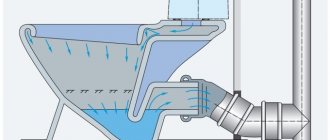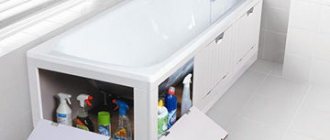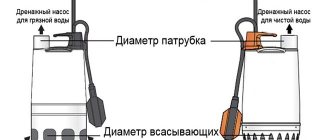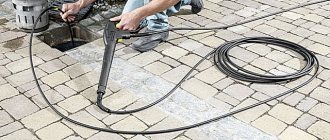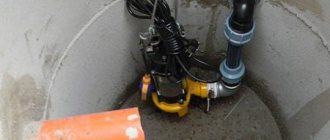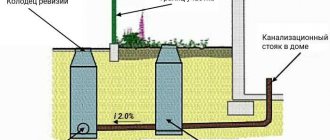Purpose of a plug for a sewer pipe
Sewer blockage for debtors
Plugs are made of metal, plastic and rubber. Polypropylene products, PVC and cast iron models are very popular. Many blocking devices have a smooth surface, which prevents the accumulation of fatty deposits on the side of the riser.
Installation of a valve or other stopping device is carried out unscheduled or in advance. The procedure is aimed at achieving the following goals:
- completely block part of the riser for its repair or partial replacement;
- close the lumen of the channel to drain and clean the clogged area;
- connect drain hoses of sinks and household appliances;
- inspect and service the joints of pipes of different diameters;
- block drains during scheduled repairs of the riser at the entrance to the apartment wiring.
The legality of installing a plug is confirmed by Art. 21 Federal Law No. 416 dated December 7, 2011
Do-it-yourself work with pipe plugs
It is worth noting that the assembly instructions will be provided as general and universal. That is, the scheme will be given in a way that everyone can apply in practice, without the presence of any expensive tools and consumables.
So, step-by-step installation of sewer plugs.
On a plastic pipe
Riser made of plastic products
In this case, you need to act something like this:
- A cork is taken and its outer surface is covered with any plumbing silicone. If silicone is not used, there will not be a truly airtight connection. This means that both odors and noise from the flow of various liquids through the pipes will penetrate into the room. (See also the article Connecting a toilet to a sewer: features.)
- There is a special groove inside the pipe outlet - as a rule, it contains a rubber rim, which also significantly affects the level of tightness. So, if such a rubber gasket is missing, then it must be inserted. In principle, an elastic band from any manufacturer should be suitable.
- The rubber band is also lubricated with silicone.
- The fitting is inserted into the pipe. If the diameter does not match and the part cannot be inserted as expected, then you can try to lubricate it with a small amount of oil and screw it in, as it were.
Important! After the sewer pipe plug is inserted, you need to leave it alone for a couple of days. That is, do not scroll, do not remove, and then insert again. If you move the fitting, the silicone will not dry completely and the seal will not be the best.
Sealant for plumbing
Agree, the work is, in principle, not difficult.
Now let's look at how to “plug” pipes made of steel or cast iron.
Blocked metal pipes
Typically, a metal sewer line is made of either cast iron or steel. In the first case, you can try to find a “native” lid at a flea market, but in the second you will have to be smart.
In fact, a plug for a steel sewer pipe is the same standard plug, but the difficulty is that it is difficult to find the required diameter of the product.
Therefore, if you can’t find a ready-made lid, try the following methods:
- Make a part from a wooden chopstick, which is treated with silicone or liquid glass. The essence of the method is that if a wooden cork comes into contact with water or is exposed to moist air, the wood will swell. And due to this property, we will obtain the required level of tightness and a strong connection.
An example of the simplest wood chopper
- Install a hydraulic seal. Essentially, it is just a cement mortar that hardens even when under water. Naturally, you don’t just need to pour it into the hole - first insert something like a lid made of strong polyethylene into the pipe so that the mixture does not flow into the riser before it hardens.
Advice: in principle, you can plug the hole with a metal plug of a smaller diameter. You just need to wrap it in a layer of tow (up to one centimeter thick) coated with silicone.
And it’s probably also worth considering how to remove such elements from pipes.
Operating principle
Plugs are installed at the entry points of sewer branches from the riser into the apartment. Since on average 1 person produces up to 100-150 liters of liquid waste per day, water will rise from the installed barrier to the riser quite quickly. As a result, residents will not be able to use plumbing fixtures in the kitchen, bathroom and toilet.
Sewage obstructions are installed in such a way as to choke the drainage system of defaulters. The drainage channels of neighboring apartments are not affected.
Is it possible to remove the plug yourself?
Removing the plug takes from several minutes to several hours, depending on the type of part and the method of its fastening. The plugs that are installed externally can be removed independently.
It is not recommended to dismantle internal limiters installed by utility services without specialists.
The simpler the installation, the easier it is to remove it later. It is not recommended to apply additional products, including sealants, to plugs that will be frequently removed, for example, for inspection.
A plug that is welded to a pipe can only be removed by cutting off the corresponding part of the pipe; these are disposable.
Types of stubs
The drainage system of residential buildings is laid underground and consists of pipes of various diameters. For domestic sewerage, this figure is usually 110 mm. In places where additional branches are supposed to be created, wiring is carried out. Outputs that are not in use are blocked with plugs.
Sewer shut-off elements are classified into several types:
- Permanent. Their installation is carried out for a long time. Such structures are installed for several months or years. Usually used if a complete sewage system is being formed. Bends and tees are installed at certain points in the pipeline. In the future they will be used to connect new objects. Permanent plugs are made of high-quality polymer or metal. Typically, such elements are represented by a convex-shaped lid. Seals are placed inside the devices to seal the structure and reduce pressure on it. Many permanent plugs are equipped with threads.
- Temporary. Provide short-term restrictions in a functional element of the sewer system. Outwardly, they resemble permanent plugs. The need for temporary plugs appears when creating an additional riser in an apartment.
- Inflatable. To install them, use a special device equipped with a long hose. The pneumatic plug for sewer pipes (PZU) is represented by a rubber ball with teeth, which is connected to the hose. The hose has a camera and several handles that make it convenient to use. The inflatable plug is lowered into the riser, usually through a top access point on the roof. The presence of a camera allows the operator to inspect the internal contents of the pipeline, so they can quickly determine where to install a multi-size pneumatic plug.
- Mechanical. Locking elements of this type are equipped with shields and have a complex design. Such plugs are installed in a certain sequence - prepare a hose with a camera, place the plug in the riser, then move it to the desired location and send an electrical signal to unfold the element. After installation, the device panels are fixed to the walls, which ensures automatic blocking of the outlet. Mechanical products are usually represented by plastic plugs for sewer pipes.
Sprut blocking devices are often used to close sewer branches for non-payment. This type of device has a built-in video camera. Using such equipment, you can plug the pipe partially or completely. In the first case, the system is configured by specialists.
Onyx plugs are a complex system consisting of a sleeve and a probe. The latter is installed using a manipulator. The body of the blocking device contains LEDs and a video camera.
Polytron plugs for internal and external sewerage are used for temporary or permanent blocking of open ends of pipes. They are made from polypropylene.
Installation technology
Methods for installing plugs depend on what type was chosen. The most common are in the form of lids with a rubberized ring. Installing them does not require special skills. To do this, just select a plug of a suitable diameter. The material from which it is made must match the material of the pipe.
A rubberized ring is placed between the pipe and the plug, with an additional layer of sealant applied to it. This will increase the tightness of such a connection. Then put on the plug before the sealant hardens, pressing it tightly against the pipe. This completes the installation process.
It is important! When installing a regular plug, there is no need to worry about its tightness. The sewerage system is a non-pressure system. The pressure inside it is small, so the plug will not move during operation or leak liquid. The main advantage of such a plug is the speed of installation and dismantling.
Threaded plugs are screwed into pipes using threads. They can often be found on metal pipes. For sewerage, this type of connection is rarely used, despite the fact that it has greater tightness than a conventional plug without a thread.
We recommend that you read: Vacuum valve for sewage systems
Gate valves with flange connections are secured using special bolts. They are installed on large highways, where there is a need for these types of plugs.
Welded ones have the best tightness. To install them, you need a special pipe welding machine. The end of the pipe and the plug are inserted into the jaws of such a device, welding these parts to each other. This is a permanent type of plug, which is also non-removable. It is not often used for sewer systems.
Pneumatic plugs are used by utilities. These are parts that are made of dense rubber and inflated to increase in volume. In the deflated state, the plug is inserted into the pipe and advanced to the outlet of the final consumer of the service. It is inflated in the right place and it closes the lumen, tightly touching the walls of the pipe.
Installation features
When the employees of the service organization have taken all measures to eliminate the debt for utilities (sending appropriate notifications), a sewer plug can be installed for the defaulter. It is installed in such a way as not to cause discomfort to other residents of the apartment building.
To install the blocking element correctly you need:
- manipulator;
- remote controlled video camera;
- fiber optic wire providing illumination of the structure.
The plug in the sewer is installed in the following sequence:
- Study the structure of the drainage system, understand what material it is made of, check for the presence of additional drainage from the defaulter’s apartment.
- Determine the installation location of the blocking device. It is installed using an internal pipe leading from the toilet to the common riser.
- Find the entry point from which the equipment will be launched into the system. For this purpose, a vent pipe located on the roof is used.
- Insert the manipulator into the water channel and gradually lower it down. The camera fixed on it allows you to find the installation location.
- When the installation point of the blocking element is reached, lower the plug and insert it from the side of the apartment sewer.
- Secure the plug.
To install a drain blocker, it is necessary to undergo training, so this work is performed only by employees of the housing and communal services or service company.
Removing traffic jams
A logical question arises here: what is so difficult about this work?
In fact, there are a lot of nuances.
Firstly, you may have a sewer plug Sprut, which is usually installed due to debt. Its essence is simple - using special equipment, a plug is inserted into the hole in your outlet from the riser, which blocks 97% of the liquid from draining.
Operating principle of the Sprut system
The problem is that dismantling such a barrier may result in fines from the relevant services (although here you still need to prove the legality of the sewer plug for debtors). But even if you close your eyes to the legal aspects of the issue, another difficulty appears - if the plug is simply knocked out, it can get stuck in the riser, and this will block the drainage of water on all floors.
Utility inspectors
Therefore, it is better not to take risks, but to use this method: take a drill, a drill bit and bore the element along the edges, and then carefully remove it.
Secondly, if the riser is cast iron and the plug is old, then it may simply not be possible to dismantle it. In most cases, they begin to attack the product with a hammer, and this can lead to the destruction of the entire pipe - cast iron is a brittle metal.
And here, too, you can try using a power tool - make small pinpoint cuts with a grinder and break off the metal in small pieces. Such work will progress slowly, but the likelihood of deformation of the entire riser as a whole will be low.
Example of a cast iron sewer pipe with a plug removed
This concludes our review and now we will summarize its results.
Methods for removing the device
Rigid plug to limit drainage
Dismantling the toilet is one of the effective ways to remove the plug. It will be practical if a modern hygienic product is installed in the toilet, bolted to the floor. Old versions are filled with cement, so it is better not to touch them, otherwise further installation in place will be impossible.
Before removing the toilet, you must:
- turn off the water;
- remove the tank and disconnect communications;
- unscrew the bolts securing the ceramic element and disassemble the bell to the first connection;
- carefully pull the plug into the apartment using pliers;
- install the toilet in place and connect communications.
Do not push the shut-off device into the riser. This will lead to clogged pipes and sewage problems throughout the house. You should not use too much force when removing obstacles, especially if the riser is cast iron - it may not withstand large mechanical loads.
To remove the plug through dismantling the toilet, you need to prepare wrenches, an adjustable wrench, a flashlight, gloves and pliers. A hammer and dowels may be helpful.
Audit
The revision is a kind of tee that allows you to clean the riser if necessary. In order to rip off the plug through it, it is important to prepare a stick with a hook in advance.
The process of dismantling the locking element:
- open the inspection cover;
- insert a stick or harpoon into the riser;
- hook the plug and pull it towards you.
When removing an obstacle, you need to wear gloves and thick clothing so that accidental discharge of water (possibly boiling water) does not cause damage to your health. The main disadvantage of the method is that the work is carried out blindly.
Parts used by utilities
As practice shows, one of the most effective means of dealing with citizens who do not want to pay for utilities is to install plugs in the sewerage system. The advantage of this solution:
- You can block access to the sewerage system within a few minutes, and there is no need to enter the apartment of a person who has a debt;
- the installation of such a plug does not in any way prejudice the residents of apartments located along the riser;
- When using this measure, the likelihood of damage to the riser or other plumbing equipment is zero.
How it works? Very simple:
- installation is carried out in the attic or on the roof, the craftsmen do not need to ask the debtor to let them into the apartment;
- the device is lowered down the riser on a cable to the required floor (monitoring is carried out using a video camera);
- the plug is inserted into the outlet hole and inflated with air;
- After installing the plug in the apartment, it becomes impossible to drain water.
Advice! There is no need to go as far as installing a plug. Even if the family is in financial difficulties, you should contact the management company and draw up an agreement on debt restructuring.
Can I remove the plug myself?
Of course, the easiest and safest way to get rid of the plug installed by utilities that blocks the exit to the riser is to pay off the existing debt. In this case, the specialist will remove the installed plug in just a few minutes. But some residents try to remove the obstacle themselves. “Craftsmen” advise using two methods:
- chemical;
- mechanical.
I would like to warn you that the riser blocking the lumen is made of the same material as the pipe itself. So, if you try to dissolve it by introducing caustic substances into the sewer, it can lead to the destruction of the pipes. And subsequent repairs may require investments that will exceed the amount of debt.
The second method of removal is mechanical. You can try to push the plug further along the riser using a plunger or a plumbing cable. But this method also has disadvantages. After such an operation, the likelihood of blockage in the public sewer system increases. Of course, this will not be a problem for a single apartment, but for the entire house, but it is unlikely that the neighbors will be delighted when the cause of the blockage is found out.
So, plugs for sewer pipes are installed for different purposes. But the function of this part is the same in all cases; it blocks the movement of fluid flow. It is quite possible to install a plug on a pipe or an open branch of the riser yourself; it is a fairly simple job.
How can residents remove a plug from a sewer pipe in their apartment?
Situations and cases are completely different. Often, small children and elderly people live in apartments where drains are blocked due to debts. Everyone has their own motives for not paying and accumulating debt, but everyone needs convenience. Therefore, unscrupulous payers have long learned to get rid of barriers and enjoy the benefits of civilization without restrictions.
However, the fastest and most profitable option at all times was to pay off utility debts. After all, no one is immune from the fact that the management company’s employees will not come again and install the probe.
By the way, the actions of residents to independently remove obstacles in the pipes are not illegal. At the same time, getting rid of the trouble does not involve gaining access to the common riser. The plug is removed from the side outlet, which belongs to the owners of the home.
Elimination methods
Removing the plug
Most often, owners act in the same ways as when a sewer is clogged or with a similar technique. But if you come across a pneumatic plug, it is useless to use chemicals like “Mole”. The material from which the damper is made has almost the same properties as the quality of the pipes. It is impossible to destroy it with a “Mole”. From experience, if you mechanically break the valve, the pipe will collapse. Repairs will cost even more.
There are the following ways to deal with obstacles in artificially created sewer systems:
- Dismantling the area adjacent to the location of the barrier, removing the obstacle manually or squeezing it out using a stick with a hook.
- If the plug is not from the “pneumo” series, you can try to punch it with a “Mole”. Spilling chemical components will take a very long time. Sometimes this takes up to 30 days.
Note that no matter who carried out the entire cycle of work to remove this “plug,” it is most rational to use the method of mechanical action. Here, a lot depends on the design of the sewerage networks in a particular house or apartment of the defaulter himself.
Stages of work
First, you need to assess the complexity of the upcoming activity and understand where exactly the hated obstacle is located. It is very easy to recognize the location of an element. It is necessary to tap the sewer pipe everywhere. In the area where there is an obstacle, the sound will be muffled. It will become sonorous only when the voids are tapped.
You need to act through the plumbing device that is located closest to the main pipe than the others. Often this is the toilet or kitchen sink. Carefully disassemble the pipe joints. Start the water and wait until it reaches the plug. A plunger must be installed above it.
Pump water, which will create increased pressure in a certain area of the system. The plug for sewer pipes should slip further and be squeezed into a pipe of a wider diameter, and then into the sewer.
Often, the installation of a damper is hasty due to ignorance of the exact location of the pipes in the system. Based on this, you can hope for a quick solution to the problem. It is important to remember one more nuance: if the main pipe is the same size as the area at the entrance to the apartment, the damper will block the common riser and the neighbors will not be able to use the sewer. In this regard, representatives of utility services will come again.
Of course, they will eliminate the obstacle, but debtor tenants are not immune from new manipulations to install a barrier on the pipes in their apartment.
How to use a specialized cable
This will not require a complete refurbishment of the sewer system. When using the cord, you must remember that it is important to rotate the cable handle only clockwise. This is due to the fact that the spiral, when it hits an obstacle in the pipe, must tirelessly compress, due to which the pressure increases and the damper is removed. If the “plug” is of very high quality, the process of pushing the cable will have to be repeated several times.
Plastic pipes require the use of a specialized cable with rubberized braiding. This will prevent you from damaging the inner surfaces of the pipes or even piercing them. The cord itself must be laid extremely carefully. You should rotate slowly, trying different directions.
Under no circumstances should the cord be pulled, and the technician’s efforts in the form of pressure should be minimal. After the valve is pushed out, you need to pour a couple of glasses of boiling water into the pipe, as well as a solution of baking soda or vinegar, also diluted in hot water. "Mole" wouldn't hurt either.


